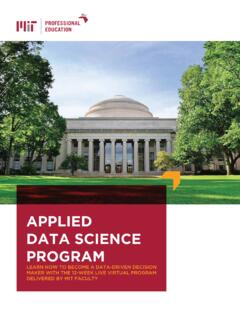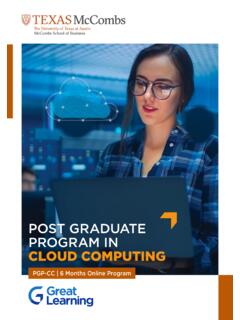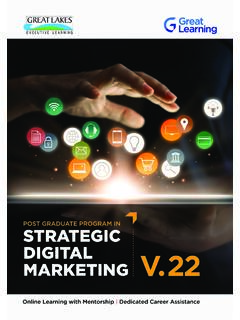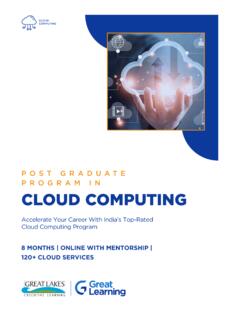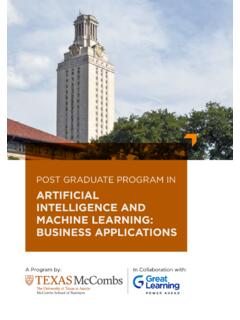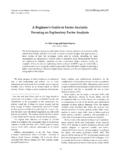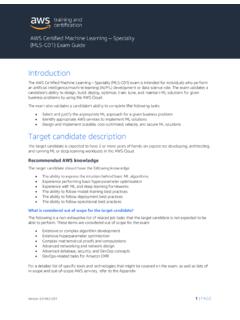Transcription of POST GRADUATE PROGRAM IN ARTIFICIAL INTELLIGENCE
1 POST GRADUATE PROGRAM INARTIFICIALINTELLIGENCE& MACHINELEARNINGV 22A relentless industry focus - that s how the PGP-AIML has been able to empower thousands of career transitions. All parts of the PROGRAM experience are designed to make learners job-ready. But here s the challenge - the industry keeps evolving all the time. Only high-quality learning has the power to transform lives, so we have high standards for our programs. To give our learners an even better competitive advantage, we are now introducing PGP-AIML to keep pace with a rapidly growing industry. With inputs from industry professionals, top academicians, and recently graduated alums, the upcoming version of the PGP-AIML is your best bet for a rewarding ARTIFICIAL INTELLIGENCE THEPG PROGRAM INARTIFICIAL INTELLIGENCE & MACHINE LEARNING: V. 223900+IndustryExpertsMentors160+Countri esReached1200+HiringPartnersGREAT LEARNINGINDIA S LEADINGPROFESSIONAL LEARNINGPLATFORMBes t Ed-techCompanyof the year**EdTechReview Awards 2020 3 Million+Learners01 Current Version Version V.
2 22 Learning ModulesIndustry sessionsPractice Hackathons2 Connect Sessions with Peers2 Virtual SessionsPractice Case studies10 Optional Modules8 5 from Previous Version +Power BI | Cloud Computing| Block Chain Choose between Saturday/Sunday Mentoring SessionsNo482 Handbook on Case Studiesby Alumni & Sessionsby Alums on How they appliedArtificial INTELLIGENCE at Work 1:1 Career Coaching SessionsCompany SponsoredHackathonsGuidance to publish Capstoneproject in reputed Journals or Present at Conferences .63 Virtual Sessions15 YesNoYes313 NoYes5 Exploratory Data Analysis| Introductory Module forDeep Learning |Model Deployment |Time Series Forecasting |General Adversarial NetworksA NEW AND ELEVATED LEARNINGEXPERIENCE FOR THE FUTURE-READYPROFESSIONAL02 Covers ARTIFICIAL INTELLIGENCE & Machine Learning technologies and applications including Machine Learning, Deep Learning, Computer Vision, Natural Language Processing, Reinforcement Learning, Neural Network, TensorFlow and many + hands-on projects using AI and ML lab.
3 This also features case studies, industry sessions with leading experts and learning from some of the top global companies like Uber, Netflix, Google, Amazon etc..For every assignment you work as part of this PROGRAM , you will get to see the solutions of the assignment as recorded walkthroughs. Recorded walkthroughs help you to understand the concepts better and analyze a problem from the view of an part of this PROGRAM , you will be making all of your submissions on Github. Github is an online repository which helps you to store all the projects and assignments you have done as part of this PROGRAM in a single place. Today, most companies look at potential recruits' Github profiles to check their technical expertise before hiring by leading academic and industry experts along with IIT-Bombay facultyWHAT MAKES THE PROGRAM UNIQUE?03 PROGRAM PEDAGOGY1. PROGRAM Delivery:The PROGRAM is delivered in an online format with weekend mentorship sessions that span over 12 months.
4 2. Online-Learning Management System:All candidates have access to the online LMS that hosts content (lecture recordings, discussion forums, assignments, reading material) and live webinars to enable the candidates to continue their learning during campus. The LMS provides an innovative learning environment that encourages collaborative approach between the candidates thus paving the way for maximizing learning Capstone Project:All candidates would be pursuing an application-oriented capstone project in the field of ARTIFICIAL INTELLIGENCE and Machine Learning. The project shall be mentored and evaluated by faculty from Great Lakes Institute of Management or industry experts. The project will be presented to the faculty board as part of the requirement for successful completion of the Industry Perspective Lectures:This is an important component of the PROGRAM that complements and substantiates learning with an applied orientation. The participants get the opportunity to listen to eminent speakers from leading ARTIFICIAL INTELLIGENCE and Machine Learning companies and assimilate the best practices discussed by them in their Experiential Learning:This PROGRAM is designed to transform candidates to business-ready ARTIFICIAL INTELLIGENCE and Machine Learning professionals through hands-on experiential learning of relevant tools.
5 This is achieved through hands-on labs, practice exercises, hackathons, quizzes and assignments on software packages such as Python, NLP and Deep Learning. 04 The curriculum of the PGP in ARTIFICIAL INTELLIGENCE & Machine Learning has been updated in consultation with industry experts, academicians & PROGRAM alums to ensure you learn the most cutting-edge U N DATI O N SMODULE 1 Introduction to Python Python Basics Python Functions and Packages Working with Data Structures, Arrays, Vectors & Data Frames Jupyter Notebook Installation & Function Pandas, NumPy, Matplotlib, SeabornSELF PACED MODULEEDA and Data Processing Data Types Dispersion & Skewness Uni & Multivariate Analysis Data Imputation Identifying and Normalizing OutliersMODULE 2 Applied Statistics Descriptive Statistics Probability & Conditional Probability Hypothesis Testing Inferential Statistics Probability DistributionsMACHINE LEARNINGMODULE 1 Supervised learning Linear Regression Multiple Variable Linear Regression Logistic Regression Naive Bayes Classifiers k-NN Classification Support Vector MachinesMODULE 2 Ensemble Techniques Decision Trees Bagging Random Forests BoostingMODULE 3 Unsupervised learning K-means Clustering Hierarchical Clustering Dimension Reduction-PCAMODULE 4 Featurisation.
6 Model Selection & Tuning Feature engineering Model selection and tuning05 Model performance measures Regularising Linear models ML pipeline Bootstrap sampling Grid search CV Randomized search CV K fold cross-validationMODULE 5 Recommendation Systems Introduction to Recommendation Systems Popularity based model Content based Recommendation System Collaborative Filtering (User similarity & Item similarity) Hybrid ModelsMODULE 3 NLP (Natural Language Processing) Introduction to NLP Stop Words Tokenization Stemming and Lemmatization Bag of Words Model Word Vectorizer TF-IDF POS Tagging Named Entity Recognition Introduction to Sequential data RNNs and its Mechanisms Vanishing & Exploding gradients in RNNs LSTMs - Long short-term memory GRUs - Gated Recurrent Unit LSTMs Applications Time Series Analysis LSTMs with Attention Mechanism Neural Machine Translation Advanced Language Models: Transformers, BERT, XLNetSELF PACES MODULEI ntroduction to ReinforcementLearning (RL) RL Framework Component of RL Framework Examples of RL Systems Types of RL Systems Q-learningSELF PACED MODULEI ntroduction to GANs (GenerativeAdversarial Networks) Introduction to GANs Generative Networks Adversarial Networks How do GANs work?
7 DCGANs - Deep Convolution GANs Applications of GANsADDITIONAL MODULE Power BI Cloud Computing Block ChainARTIFICIAL INTELLIGENCEMODULE 1 Introduction to Neural Networks and Deep Learning Introduction to Perceptron & Neural Networks Activation and Loss functions Gradient Descent Batch Normalization TensorFlow & Keras for Neural Networks Hyper Parameter TuningMODULE 2 Computer Vision Introduction to Convolutional Neural Networks Introduction to Images Convolution, Pooling, Padding & its Mechanisms Forward Propagation & Backpropagation for CNNs CNN architectures like AlexNet, VGGNet, InceptionNet & ResNet Transfer Learning Object Detection YOLO, R-CNN, SSD Semantic Segmentation U-Net Face Recognition using Siamese Networks Instance Segmentation 06 TOOLS AND MORE1. To identify the potential customers who have a higher probability to churn using ensemble prediction modelA telecom company wants to use their historical customer data to predict behaviour to retain customers.
8 You can analyse all relevant customer data and develop focused customer retention To cluster the vehicles as per their fuel consumption attributes and later train a regression model for an automobile datasetThe purpose is to classify a given vehicle as one of three types of vehicles, using a set of features extracted from the silhouette. The vehicle may be viewed from one of many different To create an automation using computer vision to impute dynamic bounding boxes to locate cars or vehicles on the X s tra c department wants to understand the tra c density on road during busy hours in order to e ciently PROGRAM their tra c Implementing an Image classification neural network to classify Street House View NumbersRecognizing multi-digit numbers in photographs captured at street level is an important component of modern-day map making. A classic example of a corpus of such street-level photographs is Google s Street View imagery composed of hundreds of millions of geo-located 360-degree panoramic images.
9 PROJECTSS cipyPandasMatplotlibTkinterPythonFlaskTe nsorFlowNumpyOpenCVKer as07 The ability to automatically transcribe an address number from a geolocated patch of pixels and associate the transcribed number with a known street address helps pinpoint, with a high degree of accuracy, the location of the building it represents. More broadly, recognizing numbers in photographs is a problem of interest to the optical character recognition community. While OCR on constrained domains like document processing is well studied, arbitrary multi-character text recognition in photographs is still highly challenging. This difficulty arises due to the wide variability in the visual appearance of text in the wild on account of a large range of fonts, colors, styles, orientations, and character arrangements. The recognition problem is further complicated by environmental factors such as lighting, shadows, secularities, and occlusions as well as by image acquisition factors such as resolution, motion, and focus the condition of the patient depending on the received test resultsThis project has two parts.
10 In the first part we are trying to predict the condition of the patient depending on the received test results on biomechanics features of the patients according to their current conditions. In part II, we need to design a supervised learning prediction model to perform targeted marketing for executing a digital marketing campaign for a build a NLP classifier which can use input text parameters to determine the label/s of the is probably the most popular task that you would deal with in real life. Text in the form of blogs, posts, articles, etc. is written every second. It is a challenge to predict the information about the writer without knowing about him/her. We are going to create a classifier that predicts multiple features of the author of a given text. We have designed it as a Multi label classification To build a recommendation system using popularity based and collaborative filtering methods to recommend mobile phones to a user which are most popular and personalised is the second largest market globally for smartphones after China.

